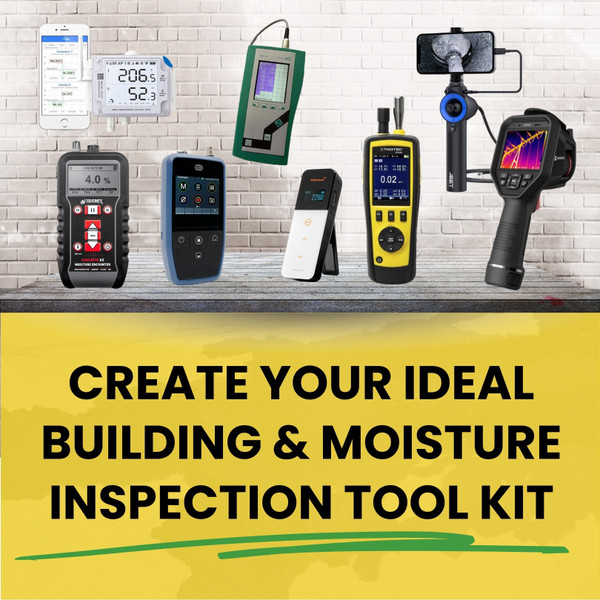The Perfect Moisture Detection Kit
Moisture Detection Tools, Techniques, and Best Practices
When faced with a water ingress situation—whether it’s a visible leak, hidden moisture, or mould growth—having the right tools in your moisture inspection kit is critical. The goal is to not only identify the problem but also to thoroughly understand the extent of the damage, justify your findings with solid data, and document everything in a professional manner.
Let's break down what your perfect moisture inspection kit should include, and how to use it effectively.
What Are You Trying to Achieve?
The primary goal of your moisture inspection kit is to gather as much accurate data as possible to understand the extent and cause of the moisture problem. Here's how each tool helps you achieve that:
- Identify the Source: Use the infrared camera to trace back temperature anomalies to their source, which is often where moisture is entering the structure.
- Measure the Impact: Use your moisture meter to determine how far the moisture has spread and what materials are affected.
- Document the Evidence: Use your videoscope to visually confirm the presence of mould or water damage and log all findings in a structured report.
Essential Components of a Moisture Inspection Kit
1. Moisture Meter with Multiple Attachments and/or Multiple Moisture Detection Devices
- Why it's essential: Moisture meters are the cornerstone of any moisture inspection kit. They are your guide to correctly detecting the presence of moisture in various building materials, including drywall, to timber and concrete. You need to ensure you use a meter that is designed for the materials you are trying to measure and understand the type of reading your meter will provide which could be relative, equivalent or absolute. Check out the informative video below from our sister company, the Australian Cleaning & Restoration Academy on this topic.

Types to Consider
- Non-Invasive Meter: Uses electromagnetic waves to detect moisture just below the surface without damaging the material. They are ideal for scanning large areas quickly and assessing surface moisture in materials like wood and concrete.
- Invasive Meter: Uses metal pins or probes (preferably insulated) that penetrate the material to measure moisture content at different depths within the structure. It’s perfect for detecting moisture in walls, wood, and other dense materials.
-
Common Attachments
- Hammer Probe: Drives pins deeper into hard materials for accurate readings.
- In-Depth Probes: Insulated long pins and paddles for moisture readings deeper within walls. The insulation allows for accurate readings of the internal materials.
- Pad Sensors: Used with non-invasive meters to scan larger surface areas.
 2. Infrared Camera
2. Infrared Camera
- Why it's essential: Identifying the extent of moisture with materials, how it may have tracked or getting a sense of the big picture will go a long way towards identifying the problem and creating a solution. An infrared camera detects temperature differentials, helping you identify potential moisture areas without invasive procedures becoming a simple and yet highly effective tool in your inspection process to narrow down the area you need to check with a moisture meter.
- How it works: Moist areas typically cool down more slowly than dry areas. By scanning with an infrared camera, you can see these differences in temperature and pinpoint the locations where moisture is likely present.
- Reinforcing your data: Use the infrared images in conjunction with moisture meter readings to provide compelling evidence of moisture issues. This dual approach strengthens your inspection report, showing both quantitative data and visual proof.
 3. Videoscope (Borescope)
3. Videoscope (Borescope)
- Why it's essential: A videoscope allows you to visually inspect areas that are otherwise inaccessible, such as inside walls or beneath floors. This tool provides a live video feed, making it easier to identify visible mould growth, water pooling, or structural damage.
- When to use It: After identifying a potential moisture problem with your infrared camera and moisture meter, a videoscope can help you confirm the extent of the damage without needing to tear apart the structure. It’s especially useful in identifying a mould issue in hidden spaces.
4. Data Logging and Reporting Tools
- Why It's Essential: Accurate data collection and reporting are just as important as the tools you use for inspection. You need to record moisture levels, temperature differentials, and visual findings to create a comprehensive report.
- Options for Consideration: Many modern moisture meters, video scopes and infrared cameras come with Bluetooth or USB connectivity, allowing you to export data directly to your device. Look for software that can compile this data into clear, understandable reports for clients, complete with charts, images, and annotations.
What Are You Trying to Achieve?
The primary goal of your moisture inspection kit is to gather as much accurate data as possible to understand the extent and cause of the moisture problem. Here's how each tool helps you achieve that:
- Identify the Source: Use the infrared camera to trace back temperature anomalies to their source, which is often where moisture is entering the structure.
- Measure the Impact: Use your moisture meter to determine how far the moisture has spread and what materials are affected.
- Document the Evidence: Use your videoscope to visually confirm the presence of mould or water damage and log all findings in a structured report.
Questions to Consider During the Inspection
- How long has the moisture been present? This can affect the severity of mould growth and the extent of structural damage.
- What materials are affected? Different materials absorb moisture differently. A moisture meter with various attachments can help you measure moisture in everything from drywall to concrete.
- What is the source of the moisture? The infrared camera helps in tracking temperature changes, which can lead you back to the origin of the water damage.
Solutions for a Successful Moisture Inspection
- Comprehensive Toolset: By combining a moisture meter, infrared camera, and videoscope, you cover all bases—surface readings, temperature analysis, and visual inspection. This ensures you don't miss any hidden problems.
- Accurate Reporting: Collect data from each tool and compile it into a detailed report. Use software that allows you to integrate images, data points, and notes seamlessly.
- Client Communication: Ensure that your findings are presented clearly. Use both the technical data and visual aids to help your client understand the issue and your proposed solutions.
A well-rounded moisture inspection kit goes beyond simply having the right moisture detection tools—it's about using them skilfully and turning your findings into practical solutions. By combining the strengths of moisture meters, infrared cameras, and borescopes, you can conduct comprehensive inspections, validate your conclusions with reliable data, and create clear, detailed reports that reinforce your recommendations. This method ensures that every moisture problem is identified and addressed, allowing you to handle any water damage situation with confidence.
Recent Posts
-
Ten Years of Restore Solutions: Innovation for Restorers
In 2015, Restore Solutions entered the market with one clear purpose — to help restoration professio …2nd Dec 2025 -
The Ultimate Battery Operated Power Scrubber for Restoration Professionals
Less Elbow Grease, More Results: Meet the Battery-Powered Scrubber That Does the Hard Work for You S …17th Nov 2025 -
Choosing the Right Cleaning Chemicals in Restoration: Work Smarter, Work Safer
Chemical safety isn’t an optional extra in restoration — it’s the foundation of professional, consis …9th Nov 2025




